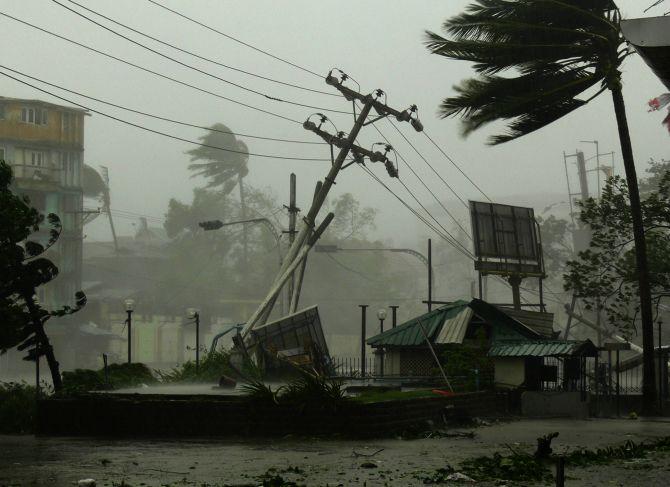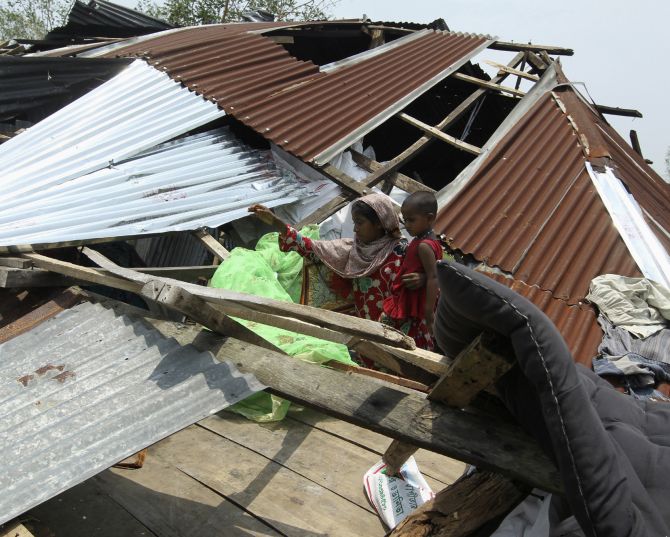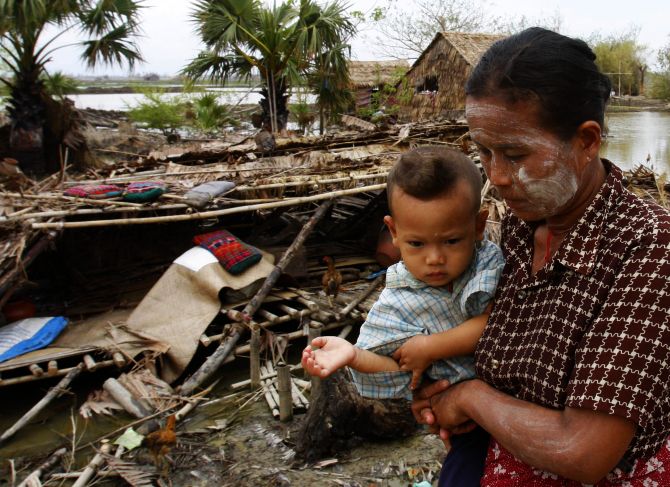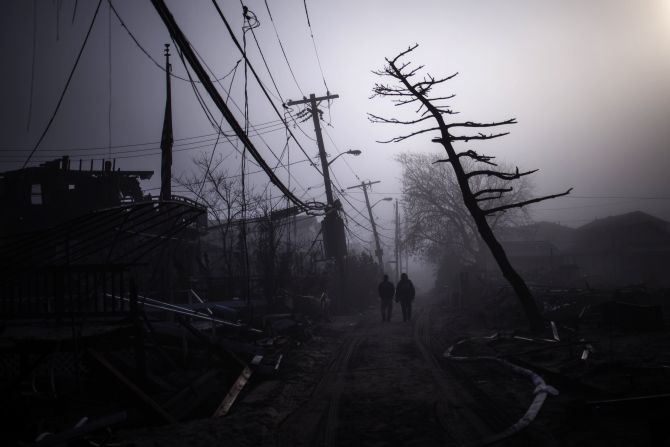Photographs: Reuters Rediff Newsdesk
As Odisha and Andhra Pradesh brace up for the "very severe" cyclone that is expected to hit the east coast with winds gusting up to 220 kmph on Saturday evening, lakhs of people are being evacuated to safer places and the military being kept on standby.
Cyclone Phailin -- the biggest cyclone in years to hit Odisha -- is expected to make landfall near Gopalpur in Ganjam district in the eastern state after crossing an area between Paradip in Odisha and Kalingapatnam in AP.
So how are tropical cyclones formed? How destructive can they be? How are their names chosen? Find out the answers to these and other questions in our cyclone FAQ.
How are tropical cyclones formed?
A tropical cyclone is a rotating, organised system of clouds and thunderstorms that originates over tropical or sub-tropical waters and has a closed low-level circulation. Tropical cyclones rotate counter-clockwise in the northern hemisphere and vice versa in the south.
“They form with a combination of very warm sea surface temperatures and the right type of outflow. Imagine a tall chimney where all the energy comes into the base and gets sucked up to the top. A lot of energy gathers in one place, which often results in thunderstorms.
In the right part of the ocean, the system can start circulating and release all that energy into the upper part of the atmosphere. The energy created from the thunderstorms can then add to the whole system and a tropical cyclone will form,” abc.net.au informs us.
Sea temperatures of 26.5 degrees or above, along with a group of thunderstorms or pre-existing conditions, create ideal weather conditions for a cyclone to form.
Please ...
How destructive can cyclones be?
Image: A woman tries to retrieve her belongings after her house was destroyed by cyclone Mahasen, in Kuakata, Bangaladesh in May, 2013.Photographs: Reuters
The main effects of tropical cyclones include heavy rain, strong winds, large storm surges at landfall, and tornadoes. The destruction from a tropical cyclone depends mainly on its intensity, its size, and its location. Tropical cyclones act to remove forest canopy as well as change the landscape near coastal areas, by moving and reshaping sand dunes and causing extensive erosion along the coast. Even well inland, heavy rainfall can lead to mudslides and landslides in mountainous areas.
Tropical cyclones out at sea cause large waves, heavy rain and high winds, disrupting international shipping and, at times, causing shipwrecks.
On land, strong winds can damage or destroy vehicles, buildings, bridges, and other outside objects, turning loose debris into deadly flying projectiles. The storm surge, or the increase in sea level due to the cyclone, is typically the worst effect from land-falling tropical cyclones, historically resulting in 90 per cent of tropical cyclone deaths.
Over the past two centuries, tropical cyclones have been responsible for the deaths of about 1.9 million people worldwide. Large areas of standing water caused by flooding lead to infection, as well as contributing to mosquito-borne illnesses.
Please ...
Which are the most disastrous tropical cyclones?
Image: Survivors of Cyclone Nargis walk near a village destroyed by the cyclone in southern Myanmar in May, 2008.Photographs: Reuters
The 1970 Bhola cyclone, which hit Bangladesh and West Bengal severely, killed 500,000 people. The 1839 Coringa cyclone, that hit Andhra Pradesh’s East Godavari district in November that year, killed an estimated 300,000 people. The storm surge wiped out the harbour city of Coringa and destroyed 25,000 ships and vessels in its bay. Survivors never rebuilt the town.
On October 7, 1737, a tropical cyclone hit Kolkata in which 300,000 people were killed. The 1975 Super Cyclone Nina also killed 229,000 people in China’s Henan province after the Bangiao Dam collapsed and devastated areas downstream.
In the recent past, the 1991 Bangladesh cyclone and 2008 Nargis cyclone in Myanmar killed 138,866 and 138,366 people respectively.
Please ...
How do cyclones differ from tornados, hurricanes and typhoons?
Image: Residents walk past damaged houses in at Queens borough, New York which was left devastated by Hurricane Sandy in November, 2012.Photographs: Adress Latif/Reuters
Hurricanes and typhoons are regional names for severe tropical cyclones, or storms with sustained winds of more than 118 kilometres per hour. The word "hurricane" is used for storms in the north Atlantic, the north-east Pacific, and the south-east Pacific.
"Typhoons" are found in the north-west of the Pacific Ocean.
Tornados are born out of thunderstorms and are tiny by comparison - generally only about 100 metres across, an abc.net.au report points out.
Please ...
How are cyclones named?
Image: Villagers, displaced from their homes by a tidal wave caused by cyclone Aila, wait for food being distributed by members of an NGO in Sundarbans, West Bengal, in June, 2009.Photographs: Parth Sanyal/Reuters
A committee at the Geneva-based World Meteorological Organisation decides the names of the cyclone many years in advance. They have a list of names for each region in the world that is responsible for identifying and classifying a tropical cyclone.
Importantly they never use the names of previous cyclones.
What should be, and should not be done during a cyclone?
Please click here to can check all dos and don’ts from the National Disaster Management Authority.






article